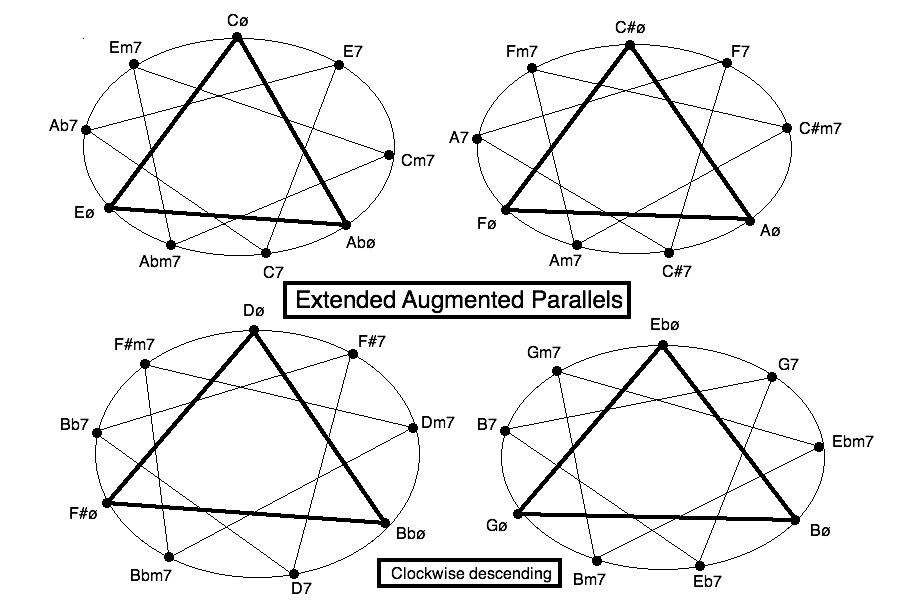www.davidskinner.net
Other academic projects
A harmonic exploration of some of the symmetrical modes
This study is a detailed extrapolation of harmonic possibilities within some of the symmetrical modes, otherwise known as "Modes of limited transposition", as given by Messiaen in his Technique of my musical language (1944).
The Diminished Scale (Messiaen mode 2)
© David Arthur Skinner 2011
The symmetry of the scale gives rise to interesting harmonic logic which is "square", in the sense that everything that occurs from one point in the scale also occurs in direct transposition at three other points. I look at harmonisation, voice-leading and intervallic possibilities.
For more technical background, see Models of Octatonic and Whole-Tone Interaction: George Crumb and his predecessors by Richard Bass.
This is a work in progress, and so I will add more over time. If you want to discuss this project with me, you can get in touch here.
Scalar architecture
The diminished scale is created by alternating 2 and 1 semitone intervals.


The scale is comprised of two diminished arpeggios. Odd degrees 1, 3, 5, and 7 form the primary diminished; even degrees 2, 4, 6, and 8 the secondary diminished.

I have used C as my root-note; however one could equally well use any other primary scale-tone for this purpose. In other words, because of the symmetry of the scale, there are four possible roots. The entire scale exists in 3 transpositions. When I use the phrase diminished scale, I always refer to the version with the half-step first.
There are three diminished arpeggios. Say that "type 1" refers to the diminished arpeggio starting on C, "type 2" to that beginning on C#, and "type 3" to that beginning on D. Then these three discrete arpeggios combine to form diminished scales as follows:

Chordal possibilities
Taking the primary degrees as roots, the following conventional chord types are possible:
| maj 6 | min 6 |
| dom 7 | min 7 |
| 7 (b5) | Ø |
| 7 (alt 9) | - |
| 13 | min 13 (no 9, no 11) |
| - | dim |
Additional upper-structure chords as follows:
| C/Db | Cm/Db |
| C/Eb | Cm/E |
| C/F# | Cm/F# |
| C/Bb | Cm/Bb |
From the secondary degrees there are some ambiguous structures. In the notation, the names are these from the given secondary root note, but it is also possible to describe them in terms of other roots, especially in inversion.

| Chord /C# | Other names |
| C#mΔ9(b5) | C/Db |
| C#mΔ9(#5) | Am/C#, A/C 1st inv. |
| C#Δ9 sus(b5) | Stacked 4ths, semitone between |
| C#Δ9 sus(#5) | F#m/C 1st inv. |
A few other non-diminished possibilities:
- Implied whole-tone clusters using degrees 1, 4, 5, 8, or 2, 3, 6, 7
- Nested perfect 5th intervals from primary degrees, separated by a semitone (i.e. C, F#, G, C#)
- Nested minor 7th intervals from primary degrees (i.e. C, A, Bb, G)
- Nested major 7th intervals from secondary degrees(i.e. Db, Bb, C, A)
Parallel movement
First: 3-note chords. Descending from tonic 1 major the following triads occur:

Rules in a nutshell:
- Descending, virtual root moves down maj 6th from major, down tritone from minor
- Ascending, virtual root moves up a tritone from major, up maj 6th from minor
Here is a diagram I made of the basic possibilities from primary scale tones. Each major and minor chord occurs once. Click to view larger version.
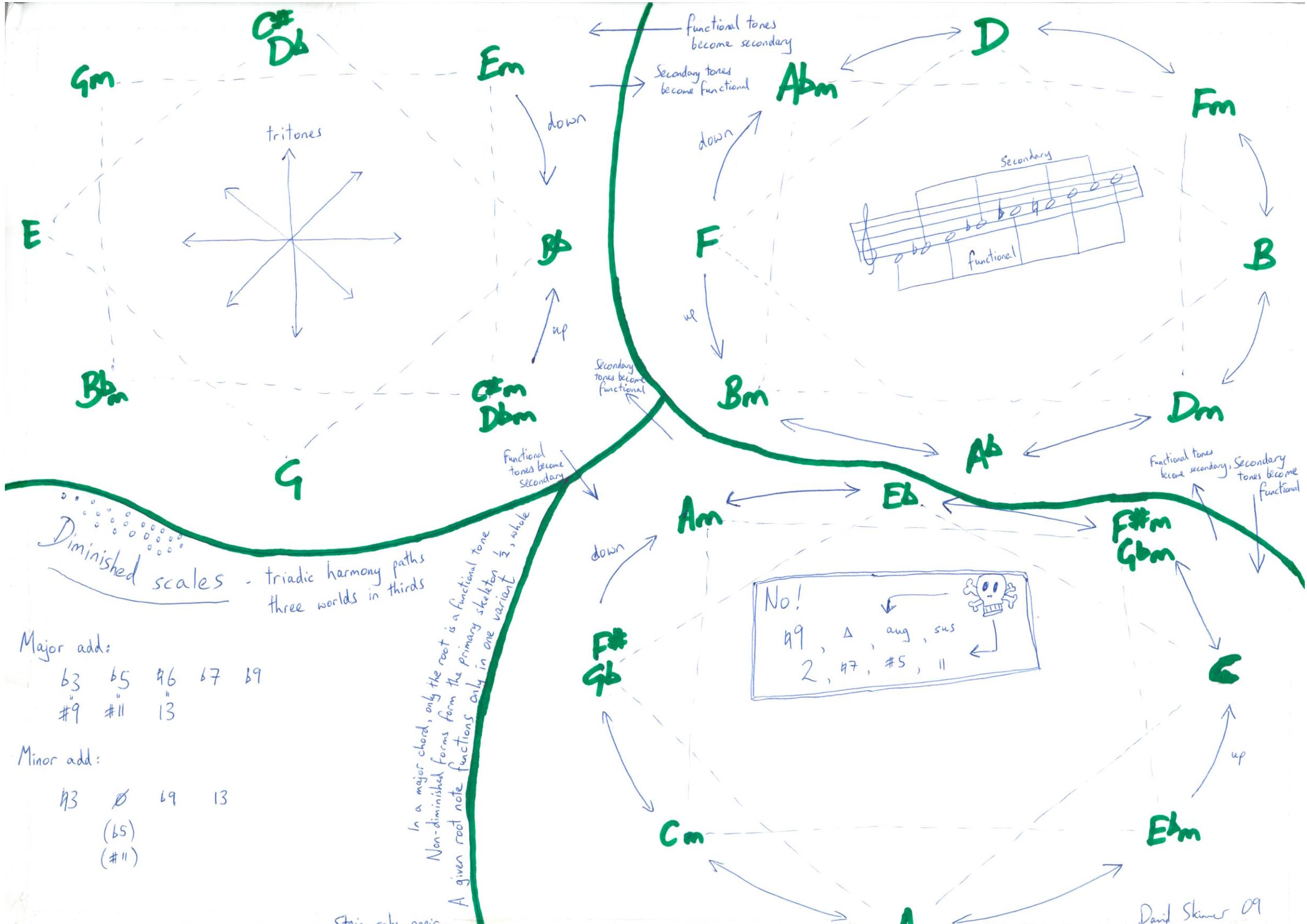
Due to the symmetry of the scale, moving stepwise in parallel motion always alternates between two forms.
Here are the main 4-note forms with their evil twins:
| Primary position | Secondary position |
| 7 #4 no3 | Δ #4 #5 no3 |
| dom 7 | Δ sus #5 |
| 7 (b5) | Δ sus b5 |
| min 7 | minΔ #5 |
| Ø | ØΔ, or (R-1)/R |
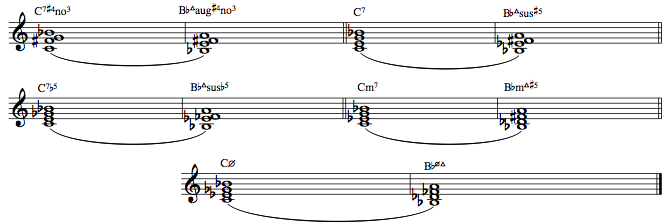
Here are these chords, with root note G, written out in full:
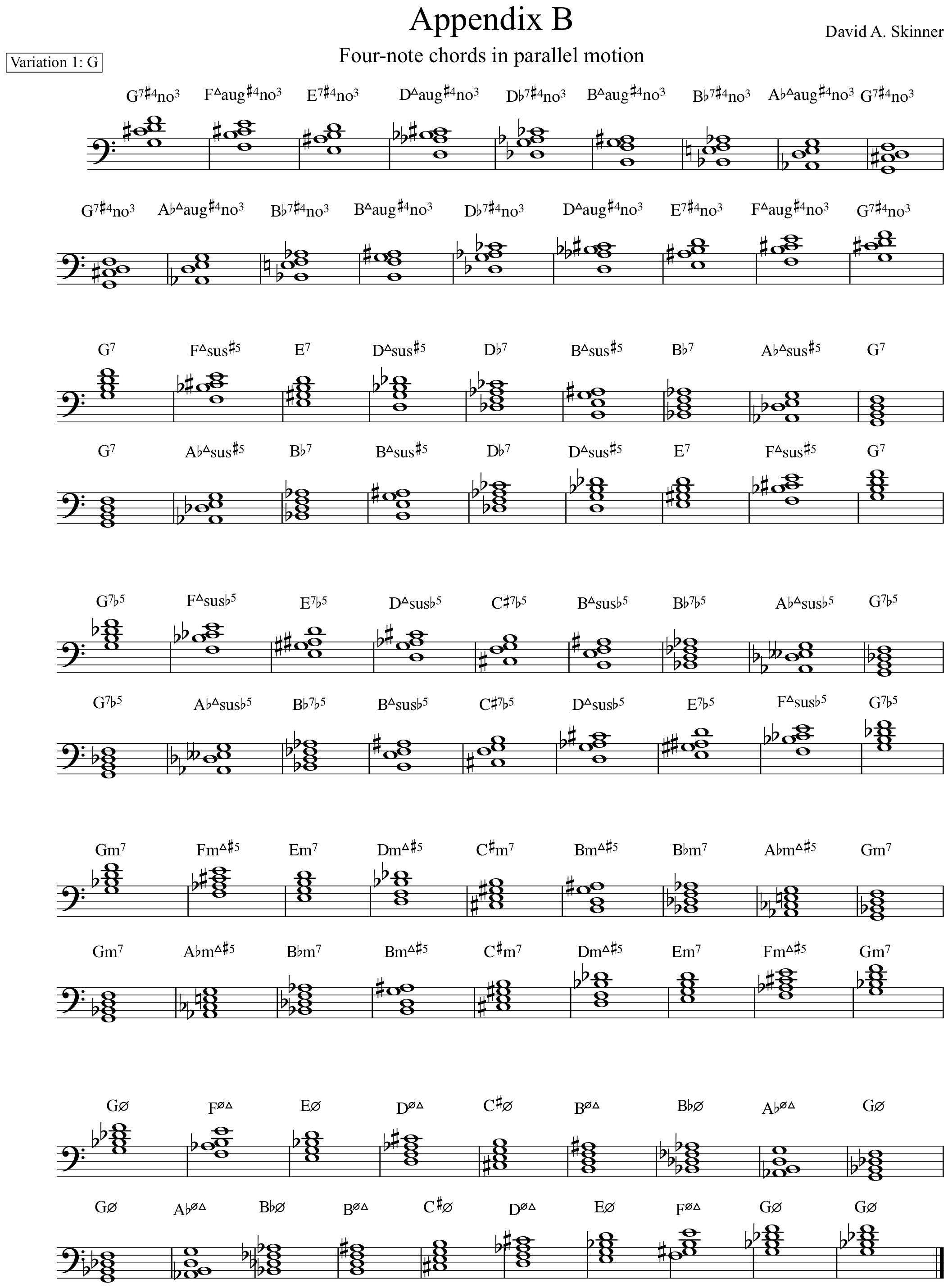
Harmonisation of a single note
Now I will look at the various functions available to primary and secondary tones as a part of various chords. I begin with triadic harmony with a primary tone in the melody.

Triadic harmony with a secondary tone in the melody:

It seems easier to use a table to demonstrate the available tones in the dominant seventh, and whether they are primary or secondary.
| Dominant seventh | |
| Root | 1 |
| b9 | 2 |
| 9 | - |
| #9 | 1 |
| 3 | 2 |
| sus4 | - |
| #11 | 1 |
| 5 | 2 |
| #5 | - |
| 13 | 1 |
| b7 | 2 |
Voiceleading
By moving only certain voices it is possible to create different progressions of non-diminished chords.
Triadic movement with one mobile voice:

Triadic movement with two mobile voices, where majors and minors are naturally separate:

When moving two voices, it is also possible to punctuate the same sequence of majors with incomplete dominant shapes (they lack the fifth), while maintaining the two-voice movement rule.

This section is being expanded
Intervallic possibilities
All possible intervals are present in the diminished scale, but only those comprised of minor thirds are found from both primary and secondary tones.

The following chart applies to intervals ascending. Available intervals descending from a given tone-class are those available ascending from the opposite class, that is, a major seventh is only available ascending from a secondary tone, but only descending from a primary tone. Intervals contained within a diminished seventh chord are available from any tone, ascending or descending: these are combinations of minor thirds, for example the tritone and the major sixth. Obviously larger intervals can be built using an additional octave. Those interval types which, after their application, have not changed the function of the tone from primary to secondary or the reverse, are shown in italics.
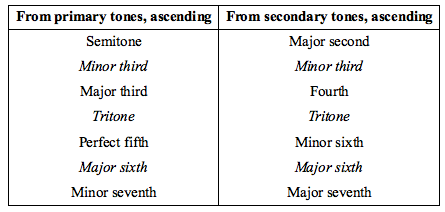
All the intervals can be arranged in order of size and played consecutively without requiring tones from outside the mode.

Structural unity can be derived from an ordering of intervallic sequence in a longer linear system.

Such interval-ordering can be treated strictly, as in a literal sequencing of their relative sizes, as in the following example:
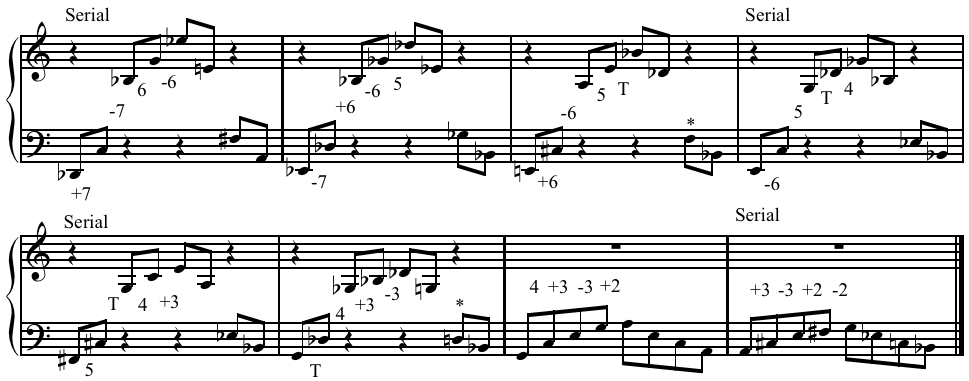
Did you find this interesting? Do you have any input? Let me know.
Back to top
© www.davidskinner.net
The extended augmented scale
(Messiaen mode 3)
The basic augmented scale is a six-note mode created by alternating the interval of a minor third with semitone steps. However, it offers fairly limited harmonic resources, and can be extended by the addition of a third augmented triad. By this means the scale retains its transpositional possibilities - it can be transposed four times, like any augmented triad - but gains harmonic flexibility.

The resulting mode is listed as one of the possible "modes of limited transposition" by Messiaen. It has three modes. Here are the conventional chord shapes available in the three modes. In this example, mode I has root C, mode II has root D, and mode III has root Eb. These roots are reflected at major third intervals.
Available chord shapes
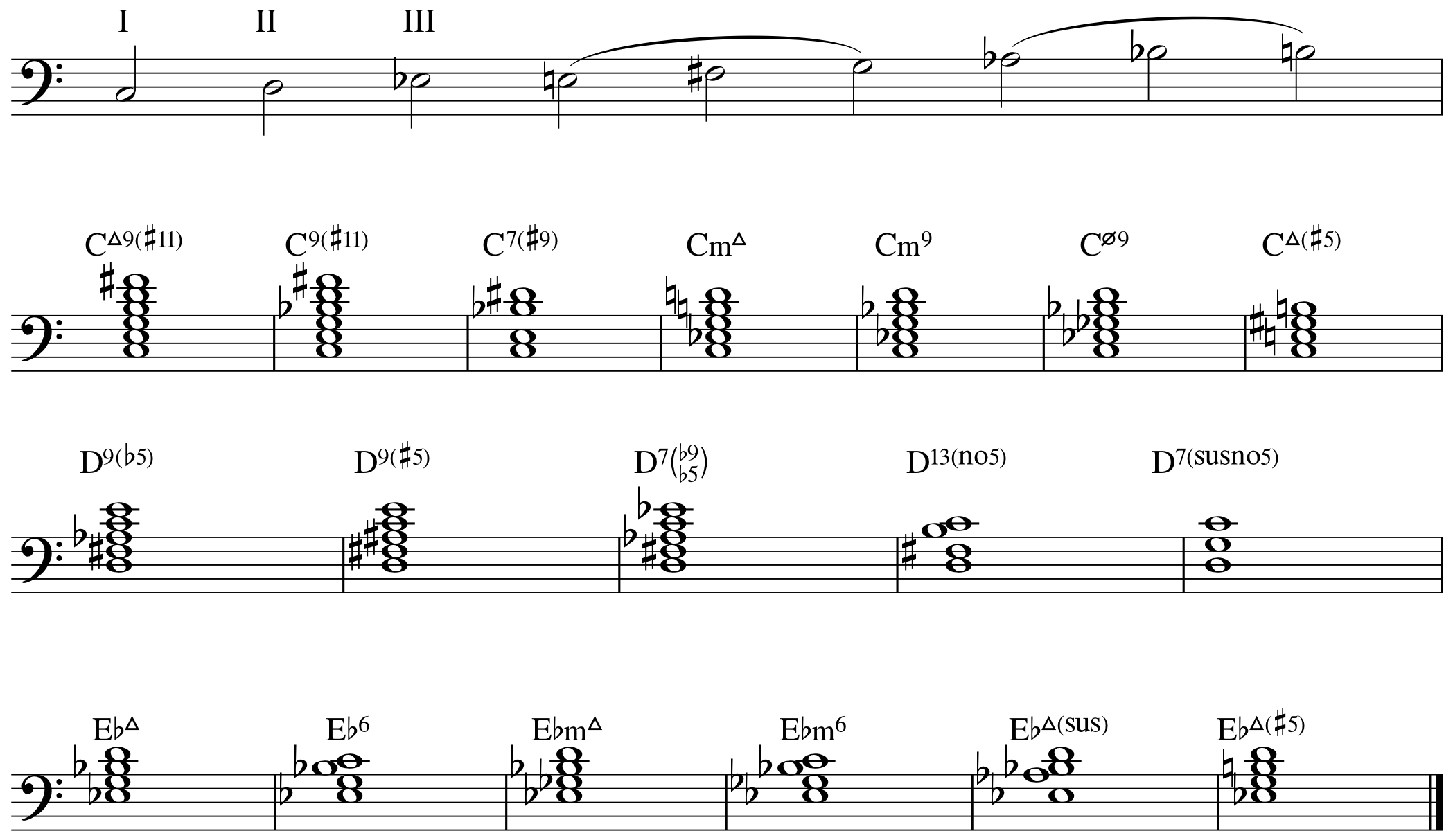
Another way of thinking about the harmonic possibilities in the three modes is to notice what tones are lacking in relation to the bass notes:
Mode 1 lacks b2 (b9), 4 (11) and 6 (13)
Mode 2 lacks maj7, m3 (#9) and 5
Mode 3 lacks b7, 2 (9) and #4 (#11).
Parallels
Below, I have extrapolated the parallel chord sequences derived from various chord-types at mode I.
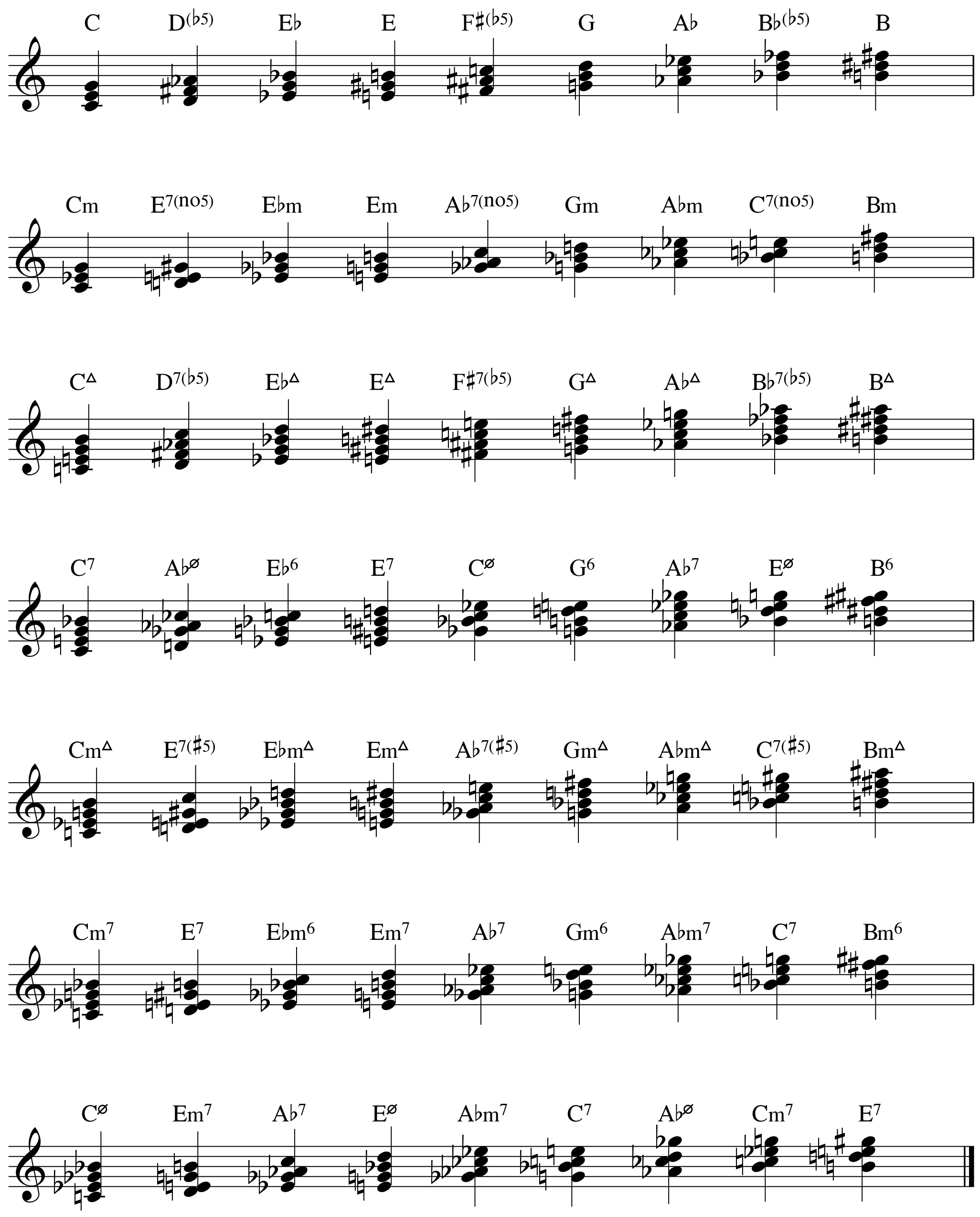
What appears to be strings of chords is actually a linear representation of a circular phenomenon. Here, one of the parallel sequences represented as a circle, in all four transpositions. It can be seen that this same sequence recurs in various 1st mode voicings.
